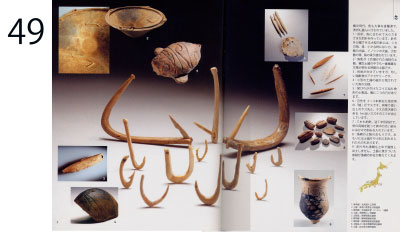During the Jomon period, fish was an important source of food, and fishing was actively engaged.
1 (large pic., center, p. 48-49):
Fishhooks. They made various sizes of fishhooks to match the size of the fish. For the large hooks where the needle can be separated, deer antler and deer bones were used as the needle. Fangs of deer, sea mammal and wild boar, bones of large animals, and bones of birds were used for smaller hooks.
2 (top left, p. 48):
A shallow bowl with depictions of two fish, from the period when the most splendid pottery decorations appeared.
3 (left, second from bottom, p. 48):
A rare piece of accessory made of a bone of a sea mammal. The end part is missing.
4 (left bottom, p. 48):
A fish pattern incised on a shard of a small piece of pottery.
5 (right top, p. 48):
A clay object of a fish that looks like a carp without a fin. There are two holes on its belly.
6 (top, p. 49):
A fishing spear made of three spearheads bound together. A worn-out spearhead, and the gills of a sea bass nearly one meter in length that has the mark of the spear, have been excavated.
7 (right, second from top, p. 49):
These are also fishhooks. They are reversed T-shape fishhooks, with both sides scraped down and notches in the thicker center part to hold the fishing line.
8 (right, second from bottom, p. 49):
Sinkers of fishing nets, made of clay. Some of the sinkers are made of pottery shards and stones with notches.
9 (bottom, p. 49):
Because fishing lines and fishing nets have all decayed underground, they cannot be found. But traces of the nets burnt onto potteries tell us of its existence.
